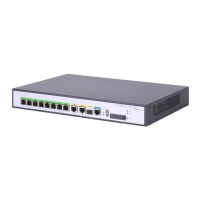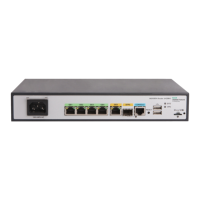140
Ste
Command
Remarks
6. Configure an
IPoEoA mapping.
map bridge virtual-ethernet interface-number
By default, no mapping is
configured.
This command references the
VE interface previously
created.
Configuring PPPoA
When two routers are connected by using DSL interfaces through a dial-up connection, configure them
as a PPPoA server and client. The PPPoA server acts as the PPP server, and you must configure an address
pool for it to assign an IP address to the remote node. The PPPoA client acts as the PPP client, and you
must configure address negotiation on it to accept the IP address assigned by the server end. For more
information, see "Configuring PPP and MP."
Perform this task to enable a PVC or PVC-group to carry PPP and configure a PPP mapping for the PVC
or PVC-group.
To configure PPPoA:
Ste
Command
Remarks
1. Enter system view.
system-view N/A
2. Create a VT interface.
interface virtual-template vt-number
N/A
3. Configure PPP authentication
and IP address. For the PPP
server, configure an address
pool to assign an IP address to
the remote node. For the PPP
client, configure address
negotiation to accept the IP
address assigned by the server
end.
For more information, see
"Configuring PPP and MP."
Configure PPP authentication
and IP address on the VT
interface instead of an ATM
interface. The IP address
configuration does not take
effect on ATM interfaces.
When you configure a static
route for the VT interface,
specify the next hop instead of
the output interface. If you have
to specify an output interface,
make sure the physical interface
bound to the VT is valid to
ensure correct packet
transmission.
4. Return to system view.
quit N/A
5. Enter ATM interface view or
ATM subinterface view.
interface atm { interface-number |
interface-number.subnumber }
N/A
6. Enter PVC view or PVC-group
view.
• Enter PVC view:
pvc { pvc-name [ vpi/vci ] |
vpi/vci }
• Enter PVC-group view:
pvc-group group-number
N/A
7. Configure a PPPoA mapping.
map ppp virtual-template vt-number
By default, no mapping is
configured.
